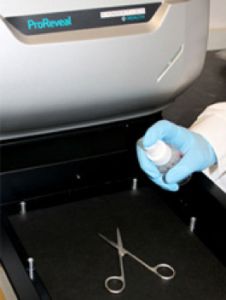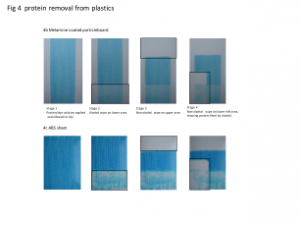Peter Bacon, Technical Director Dentisan
Aims & Objectives
- To teach readers how alcohol-based cleaners fix protein to surfaces.
- Recognise the effect fixed protein has on overall decontamination of surfaces and equipment.
- To teach readers how protein fixation can be avoided.
Learning Outcomes
- Readers will be aware of how alcohol-based cleaners fix protein to surfaces.
- Readers will know the effect fixed protein has on overall decontamination of surfaces and equipment.
- Readers will be aware of how protein fixation can be avoided.
The objective of decontamination procedures is to reduce the risk of cross-infection to patients and staff, and is accomplished by a combination of cleaning and disinfection operations.
Cleaning refers to the removal of any soiling, where pathogens and proteinaceous material are likely to be present, from surfaces, whilst disinfection means the deactivation of pathogens. Disinfectants work best in clean conditions so disinfecting without cleaning can be limited in effectiveness if the disinfectant used is unable to provide an effective cleaning action for all the soil types present.
Alcohol solutions act rapidly without leaving any surface residue, providing effective inactivation of a wide range of microorganisms. Their fast-drying property is seen as an advantage in the fast turn-round of patients and the availability of a wide range of alcohol based preparations has led to widespread adoption of these products in dental decontamination.
Why is protein fixation problematic?
On clean surfaces requiring disinfection there is little soiling matter present and inactivating any remaining microorganisms is the main focus. Where extensive soiling matter is present, its removal is important if complete disinfection is to be achieved. If proteins are present and an alcoholic solution is used as a disinfectant, proteinaceous material can be fixed to the surface, possibly trapping microorganisms and providing additional surface roughness to aid adhesion of further soiling.
Demonstrating the effects of alcohol and protein fixation
Protein can be fixed onto a wide range of solid surfaces including metals, plastics and coated materials commonly found in dental surgeries. This study used stainless steel (grade 316), dental hand pieces, ABS plastic and melamine coated particleboard to demonstrate fixation.
Stainless steel plates were cleaned using a detergent solution, rinsed and treated to remove any traces of surfactant, oil or grease. Bovine serum albumin solution was evenly applied to the surface of each plate and allowed to dry.
Hand pieces were cleaned using a detergent solution, rinsed and treated to remove any traces of surfactant, oil or grease. They were dipped in a BSA solution and allowed to dry.
Application of disinfectants to metal surfaces
Wet wipes: The surface was uniformly wiped once then again with a fresh wipe. Wiped surfaces were allowed to dry followed by a cold-water rinse process in a washer disinfector. (Getinge WD14 Tablo).
Solutions: Test pieces were immersed in the relevant alcohol solution for the required contact time, rinsed and left to dry. A cold-water rinse process was then carried out in a washer-disinfector. (Getinge WD14 Tablo).
Quantification of residual protein
 Residual protein was assessed using the ProReveal system. ProReveal reagent is sprayed over the item’s surface which is then placed inside the ProReveal Viewer, where specially configured lighting causes the spray to fluoresce where it has reacted with any residual protein. An image is displayed on screen which shows fluorescence on the instrument, indicating any remaining protein.
Residual protein was assessed using the ProReveal system. ProReveal reagent is sprayed over the item’s surface which is then placed inside the ProReveal Viewer, where specially configured lighting causes the spray to fluoresce where it has reacted with any residual protein. An image is displayed on screen which shows fluorescence on the instrument, indicating any remaining protein.
Preparation of plastic and coated materials
Melamine coated particleboard and ABS white plates were cleaned, degreased and dried. The protein was prepared using fresh egg white with addition of the appropriate marker dye quantity.
Disinfectants on plastic surfaces
Disinfectants were applied via wet wipes in a standard pattern and with a standardised wiping technique (fig 6a).
Residual protein was assessed using the depth of remaining marker dye colour as an indicator. Application of a non-alcohol wipe across the previously untreated and alcohol treated areas demonstrates the presence of fixed protein.
Results
Fig 1 shows the effect of protein fixation on stainless steel by different alcohols with different contact times. The degree of fixation was similar for 30% and 70% solutions. Contact times of 30 seconds and 5 minutes produced fixation to the same extent.

Fig 2 illustrates the results obtained using dental hand pieces. Significant fixation is seen using an alcohol-based wipe compared with a water-based preparation.

Fig 3 shows the results for fixation of protein to melamine coated particleboard and ABS surfaces. Again, protein is strongly fixed to these surfaces by alcohol and the fixed material is resistant to a subsequent detergent treatment.

How can protein fixation be avoided?
To avoid protein fixation, disinfection using alcohol-based preparations or disinfectants with other fixatives can be carried out after thorough cleaning with a water-based formulation in a two-stage process. Alternatively, a faster, single-stage cleaner and disinfectant based on chemistry that does not fix proteins can be used.
Conclusion
Alcohol rapidly fixes proteins to hard surfaces. The degree of fixation is largely independent of the alcohol type, or contact time with protein, but is influenced by formulation specifics. Fixation of proteins is not observed when water-based formulations without alcohols or other fixatives are used.
